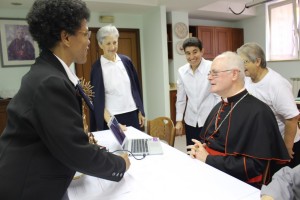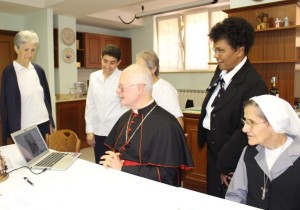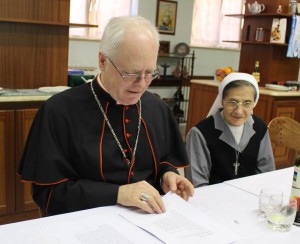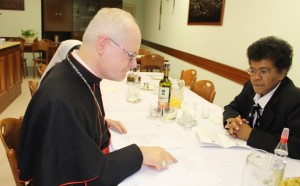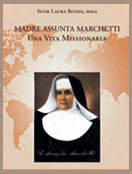Madre Assunta Marchetti è Beata! Una vita per i migranti e gli ultimi del mondo
E’ la festa della migrazione. Oggi, 25 ottobre, qui a San Paolo del Brasile si celebra la solidarietà, la carità, l’assistenza, la meravigliosa, incondizionata fede in Dio. Oggi diventa beata Madre Assunta Marchetti, cofondatrice delle suore missionarie di San Carlo Borromeo, meglio conosciute come scalabriniane, dal nome del vescovo di Piacenza, Giovanni Battista Scalabrini, loro fondatore. Madre Assunta è nata in Italia, in Toscana,a Lombrici di Camaiore il 15 agosto 1871. A 24 anni parte per il Brasile come missionaria per aiutare gli orfani dei migranti – molti, all’epoca, italiani – e per dare sollievo, in un primo tempo anche ai figli orfani, degli schiavi e ai bambini abbondonati. Essa e un modello perché svolse eroicamente la sua attività missionaria nel mondo, è un modello soprattutto per le Suore Missionarie Scalabriniane che ancora oggi, in buona parte del mondo, prestano la loro opera missionarie in nome di Dio. L’evento è organizzato dalle Suore Missionarie di San Carlo Borromeo Scalabriniane e dall’Archidiocesi di San Paolo del Brasile, nella Cattedrale metropolitana di San Paolo, a partire dalle 10. La celebrazione eucaristica è presieduta dal Cardinale Odilo Pedro Scherer, arcivescovo di San Paolo e il rito di beatificazione è presieduto dal cardinal Angelo Amato, prefetto della Congregazione delle Cause dei Santi. “Madre Assunta è stata una donna forte, dalla spiritualità straordinaria. Il suo impegno missionario è la conseguenza della sua intensa vita interiore, alimentata dalla preghiera costante: personale, comunitaria e liturgica. Madre Assunta viveva abitualmente alla presenza di Dio, in unione con lui – ha spiegato Suor Neusa de Fatima Mariano, superiora generale delle scalabriniane. La sua vita fu straordinariamente operosa, ma anche tessuta di preghiera, perché la preghiera nutriva il suo spirito e lo faceva trasbordare a quanti le si avvicinavano. A Madre Assunta non mancarono difficoltà e sofferenze, tuttavia questo non alterò mai la serenità e la dolcezza del suo cuore. In Madre Assunta tutto è puro, equilibrato, ponderato e naturale, comunicante bellezza, armonia e interiorità. E’ un modello di vita da contemplare, un esempio di cui permeare il nostro futuro di speranza, una figura di cui proporre lo stile di essere donna, oggi, figura femminile che interpella ciascuna e ciascuno a rendersi disponibile ad aprire nuovi cammini nel mondo della mobilità umana”.
Scalabrinians. Popes’ Portrait Artist is in Sao Paulo for the beatification Mother Assunta and “reveals” her masterpiece
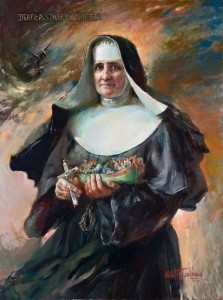
The official portrait artist of the Popes is in São Paulo, Brazil for the beatification of Mother Assunta Marchetti. She in non-other than, Natalia Tsarkova, who was commissioned to create the official portrait of the “Blessed” of the Scalabrinian Missionary Sisters. She painted an oil on canvas that depicts her standing very firmly, despite the stormy sea in the background, and the weather that almost rips her dress. Behind Mother Assunta, you see a ship in a dramatic moment: it is on the verge of being overwhelmed. Instead, all the people who are in the ship are saved and are safe on the boat (symbol of the Church) that Mother Assunta meanwhile embrace, clasping her to the heart with a protective love.
In the portrait, the green boat (color of hope), with the red border (color of faith and love) is the Congregation. In the boat you see, a humanity varied, two Missionary Sisters who take care of the needy, wearing a modern suit that indicates the continuation of the activity of the Congregation done in a more dynamic manner. One of them gives drink to a thirsty person (a representation of mercy and charity); the other, in front of the boat tenderly embrace a small child (symbol of love of neighbor, and protection). In her right hand, the mother holds the crucifix in an ‘indicative’ way on how she was writing with her hearts suffering and weary, full of fear and despair, the only message that can give strength and save: Faith. At the bottom of the cross, we see a transparent drop represents a tear of joy of salvation.
“For me it was a great responsibility to create the official image of this great Blessed. Before starting a portrait, for me it is critical of blending in character as much as possible – Tsarkova explained. When I read her biography, there entered steadily and profoundly in my heart filled with joy. I was impressed and moved by her extraordinary heroic life, full of courage and of love, of suffering and sacrifice, always joyful, continuing her spiritual journey, guided by faith, hope and charity, always ready to give herself to the orphans, the poor, immigrants and the needy. I began to feel Mother Assunta’s presence beside me. I felt that, with the breath of the Holy Spirit, the difficult task of refer proved easier than expected.
“The giant image of about eight meters of Natalia Tsarkova will be unveiled during the celebration of the beatification at the Cathedral Se, Sao Paulo Brazil.
Madre Marchetti beata .
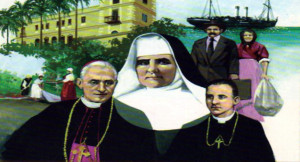
Madre Assunta Marchetti, cofondatrice delle Scalabriniane sarà proclamata beata il 25 ottobre
Il 25 ottobre 1895 pronunciava i voti privati di povertà, castità e obbedienza come “Ancella degli orfani e dei derelitti all’estero” davanti al vescovo Scalabrini in episcopio a Piacenza.
A distanza di 119 anni, Assunta Marchetti, cofondatrice delle Suore Missionarie di San Carlo Borromeo, note come Scalabrinane, sarà proclamata beata il 25 ottobre, nella Cattedrale di San Paolo in Brasile. Piacenza, dove ha sede la Congregazione, accoglierà dal 22 ottobre pellegrini provenienti da vari Paesi d’Europa per vivere insieme l’evento.
EVENTI TRA PIACENZA E CAMAIORE. Venerdì 24 ottobre alle ore 9 sarà celebrata una messa nella Cattedrale di Piacenza accanto all’urna del beato Scalabrini. Alle 10.30 visita alla Cappella dell’Immacolata, per le Scalabriniane “Cappella dell’invio”, in Episcopio, e posa del quadro che riproduce l’invio in missione. Per chi lo desidera, è possibile condividere insieme ai pellegrini anche la messa solenne nel giorno della beatificazione dalla Collegiata di Camaiore. Si parte da Piacenza (piazzetta San Savino, 29) in pullman nella mattinata del 25 ottobre; rientro in serata. Costo: 30 euro, comprensivo di pranzo e kit della Beatificazione. Per informazioni: suor Assunta e suor Marina, tel. 0523.317426 oppure 0523.325267.
UN VULCANO DI CARITÀ. “Sotto quel velo si nasconde un vulcano di carità”, era solito dire di Madre Assunta Marchetti il medico di uno degli ospedali dove prestò servizio come infermiera. Era partita dalla natìa Lido di Camaiore a 22 anni per seguire il fratello più grande, don Giuseppe, in Brasile. Il sacerdote aveva conosciuto la sofferenza dei parrocchiani di Compignano, nel lucchese, costretti a emigrare Oltreoceano. Conquistato dall’ideale del vescovo di Piacenza Scalabrini, pensava all’inizio di limitarsi a fare il cappellano a bordo di una delle tante navi su cui si stipavano i migranti in partenza da Genova. Ma un giorno un papà, disperato per la morte della moglie durante la traversata, gli mette in braccio il figlio neonato: “ci pensi lei”. “Ci vogliono delle mamme”, si disse allora Giuseppe, pensando ai tanti bambini che, come quel piccino, rimanevano orfani in un Paese sconosciuto e sconfinato. Assunta aveva dovuto rinunciare a diventare carmelitana per aiutare in casa – i Marchetti erano ben 11 figli! – dopo la prematura scomparsa del papà. Seguendo gli orfanelli raccolti da Giuseppe avrebbe trasformato ogni gesto di servizio in una preghiera perpetua. Trovata la strada della sua vocazione, si trova però a fare i conti con un fatto che nessuno aveva previsto. Il 14 dicembre 1896 don Giuseppe muore, a 27 anni, consumato dal tifo contratto nei viaggi missionari nelle fazendas. È passato poco più di un anno dal loro arrivo in Brasile e l’Orfanotrofio Cristoforo Colombo sul colle dell’Ipiranga, a San Paolo, accoglie già 180 orfani.
Ad Assunta va il merito di aver portato avanti l’opera, sfidando ostacoli e persecuzioni pur di custodire il carisma che l’aveva fatta abbandonare per sempre l’Italia: l’assistenza agli emigrati italiani e ai loro bambini. Per questo è riconosciuta, insieme a don Giuseppe, come co-fondatrice delle Suore Missionarie di San Carlo, le Scalabriniane. Con lei la Congregazione acquisisce il riconoscimento della Santa Sede e si espande al Sud del Brasile, dando vita a scuole, centri per anziani, orfanotrofi, sanatori.
All’avventura missionaria di Giuseppe ed Assunta Marchetti Il Nuovo Giornale ha dedicato uno dei suoi libretti nella collana “Testimoni della fede”.
Scalabriniane, Cardinal Scherer visita congregazione generale in attesa beatificazione Madre Marchetti
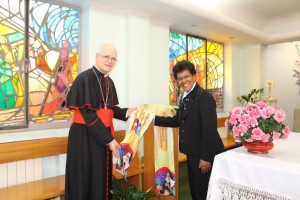 L’arcivescovo di San Paolo del Brasile, Odilo Pedro Scherer, componente del sinodo per la famiglia, ha visitato oggi la Casa generalizia delle Suore Missionarie di San Carlo Borromeo – Scalabriniane di Roma. Lo ha fatto in preparazione della cerimonia della cofondatrice delle Missionarie, Madre Assunta Marchetti, per il prossimo 25 ottobre proprio a San Paolo. “E’ con grande piacere che abbiamo accolto il cardinale Scherer nell’ottica di una collaborazione profonda che stiamo avendo giorno dopo giorno proprio con l’arcidiocesi per la beatificazione di Madre Assunta. Per tutta la famiglia scalabriniana il prossimo 25 ottobre sarà un momento storico fondamentale. Sarà una nuova occasione per riunirci in preghiera attorno alla nostra cofondatrice. L’Italia e il Brasile, ma anche tutto il mondo, sono uniti a sostegno dei migranti sotto l’esperienza missionaria di Madre Assunta”. Il Cardinale Scherer presiederà nella Cattedrale di San Paolo la celebrazione eucaristica mentre il rito della beatificazione sarà presieduto dal cardinale Angelo Amato, prefetto della Congregazione delle cause dei Santi
L’arcivescovo di San Paolo del Brasile, Odilo Pedro Scherer, componente del sinodo per la famiglia, ha visitato oggi la Casa generalizia delle Suore Missionarie di San Carlo Borromeo – Scalabriniane di Roma. Lo ha fatto in preparazione della cerimonia della cofondatrice delle Missionarie, Madre Assunta Marchetti, per il prossimo 25 ottobre proprio a San Paolo. “E’ con grande piacere che abbiamo accolto il cardinale Scherer nell’ottica di una collaborazione profonda che stiamo avendo giorno dopo giorno proprio con l’arcidiocesi per la beatificazione di Madre Assunta. Per tutta la famiglia scalabriniana il prossimo 25 ottobre sarà un momento storico fondamentale. Sarà una nuova occasione per riunirci in preghiera attorno alla nostra cofondatrice. L’Italia e il Brasile, ma anche tutto il mondo, sono uniti a sostegno dei migranti sotto l’esperienza missionaria di Madre Assunta”. Il Cardinale Scherer presiederà nella Cattedrale di San Paolo la celebrazione eucaristica mentre il rito della beatificazione sarà presieduto dal cardinale Angelo Amato, prefetto della Congregazione delle cause dei Santi
Le parole del sindaco
“Il Comune di Camaiore, terra dove affondano le radici i natali di Madre Assunta, festeggia questo avvenimento che esalta i valori della generosità, dell’altruismo e della solidarietà, che nella vita della Sorella suddetta hanno trovato la loro massima e più elevata espressione”. Questo il commento del sindaco di Camaiore, Alessandro Del Dotto, sindaco della città Natale di Madre Assunta Marchetti, nata esattamente nella frazione di Lombrici.
A Great Feast for Mother Assunta Marchetti? But who is she?
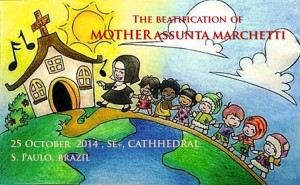 There is a big celebration in San Paulo, Brazil: Mother Assunta will be declared Blessed! Mother Assunta is a very special person; co-founder of the Missionary Sisters of St. Charles Borromeo-Scalabrinians, and today in a grand celebration for everyone, will become “Blessed”.
There is a big celebration in San Paulo, Brazil: Mother Assunta will be declared Blessed! Mother Assunta is a very special person; co-founder of the Missionary Sisters of St. Charles Borromeo-Scalabrinians, and today in a grand celebration for everyone, will become “Blessed”.
On the 25th of October, in the Metropolitan Cathedral of St. Paul, the Catholic Church decided to remember her in a special way. But what has Mother Assunta done, that is so important? She was an Italian and was 24 years old, when she chose to leave Europe in the 1800’s, and travelled to Brazil to help the poorest among the poor. She went with great courage, seeking out the Italian immigrants who travelled the long sea route to reach America, in search of new hope for their lives. In fact, in Italy, many families were in misery and had no way to get out of it, other than by emigrating.
Beatificación de Madre Assunta Marchetti
Beatificación de Madre Assunta Marchetti.
Co-fundadora de las Hermanas Misioneras de San Carlos Borromeo -Scalabrinianas
25 de octubre de 2014 – Catedral Metropolitana de San Paulo, Brasil.
Nació en Lombrici di Camaiore (Lucca) el 15 agosto 1871 y murió el 1° julio 1948 en São Paulo (Brasil), en el Orfanato Cristóbal Colón, junto a las huérfanas como siempre había querido. Ella, como Jesús, “Pasó la vida haciendo el bien a todos”.
http://www.amigodelhogar.net/2014/09/beatificacion-de-madre-assunta-marchetti.html
BLESSED MOTHER ASSUNTA MARCHETTI – Biography
Assunta Marchetti was born in Lombrici, a small town of Camaiore in the Lucca area of Italy, on August 15, 1871 and was baptized the next day. She is the third of eleven children, the first girl of the humble family of Angelo and Carola Marchetti. Since her infancy, she was raised in the principles of the Christian faith. Her formation was particularly influenced by her aunt Caterina who was a religious and director of the school where Assunta learned a modest cultural heritage, as she could not remain there long for family reasons, the mother’s poor health and many children. Aunt Caterina collaborated to instill love for the Christian virtues in the young lady’s heart.
In 1883, Maria Assunta was confirmed at five years of age; receiving the First Eucharist at age twelve. She continued, if she could daily, to receive the Eucharistic Lord whom she learned to love and follow as the only God. Gifted with strong vitality and inner energy, she knew how to manage it for the good of others, becoming servant at home with the youngest siblings and even replacing her father in the work at the mill.
While still an adolescent, she felt the call to the cloistered religious life but had to postpone her entrance in the cloister because her brother Joseph wanted to become a priest and the family with scarce resources could not afford the departure of both. Assunta remained at home and continued to help her parents and siblings.
In 1895, when Father Joseph, a missionary among the Italians who had emigrated to Brazil, asked her to be missionary in a distant land where many countrymen “were born and dying like animals”., Assunta at 24 years of age, before the image of the Sacred Heart of Jesus, discerned and decided to say Yes to the Lord who was calling her through her brother and the cry of countrymen who by emigrating sought the bread which was scarce in their homeland.
She set out for Piacenza with her missionary brother, her Mother and two other companions, to go to see Bishop Giovanni Battista Scalabrini. And on October 25, 1895, she pronounced her first religious vows in the hands of the Bishop Founder, Blessed John Baptist Scalabrini.
On October 26,1895, she became “migrant with the migrants forever,” boarding a ship together with many poor people who, disappointed in the homeland, were leaving with the hope of finding bread elsewhere. During the long crossing, she took advantage to catechize 83 children who upon arrival in Brazilian lands received first Holy Communion.
Having settled in Brazil Assunta began her mission in the Christopher Columbus Orphanage, Ipiranga, San Paulo, where she was mother, nurse, and a sort of factotum (jack of all trades), caring for the small children and promoting the growth of faith in every one that arrived at the orphanage. Sister Assunta had no pretenses. With ready availability she accepted the various services that were needed with tenderness and kindness towards all the orphans and sisters. In October 1897, she made her first perpetual profession (privately) in the hands of Fr. Faustino Consoni, delegate of Scalabrini, Bishop-founder.
The Institute underwent various crises, but the storms gradually calmed down and God blessed the emerging Congregation with new vocations and missionary beginnings in places of Italian migration. As an expression of her surrender to the Lord together with the migrants who sought their bread far from their homeland, Assunta profoundly loved He who was calling her. She became the servant of all, performing different tasks with true humility and genuine charity: catechist, educator, nurse, cook and superior general. Always aware of “being a useless servant” spreading the precious nard of love” wherever she went: especially in the orphanages, in the parochial schools and in the Houses of Mercy for the sick. In the villages dispersed among the mountains and where the doctors could not go, she went on horseback or by wagon to take medicine for the body and to be the presence of God’s mercy.
In the religious communities, she was an example of a consecrated religious, a woman of lively faith, charitable towards the neediest and the simple servant of the sisters of the community. She was a hopeful person because she relied on the God of hope who sees and provides for his children. During the trials of life, she was serene and balanced. She knew how to be silent, forgive and serve with discretion. Confident of the love of the ‘heavenly bridegroom’, as she habitually called him, Assunta dedicated herself to the service of the neediest persons, as well as to night hours of adoration in the twilight of the small chapel. She had a filial relationship with the Blessed Virgin Mary – always keeping in her hands the holy Rosary that she willingly recited while going from one bedside of the dying to the other or while watching over the sleeping children of the shelter. She was strong, meek and trusted and often said: “God sees, God provides”. And so it came to pass in her life of faithful believer. Three times she had to make the novitiate because of undue interference in the Institute, but she remained a determined guardian of the female Scalabrinian charism. For this we consider her a sort of “cornerstone” of the building of the Congregation of the Missionary Sisters of St. Charles Borromeo – Scalabrinians.
She was superior General of the Congregation for three terms and served in different missions, always a lively expression of her self-giving to the “heavenly bridegroom”. In illness, she was patient and detached from herself, always attentive to others. Her wish was to die among the children of the orphanage and so it happened. She departed for the heavenly Father’s House on July 1st, 1948 at Villa Prudente, San Paulo, Brazil.
The cause of beatification began on June 12, 1987, in San Paulo, Brazil. In view of the beatification of the Servant of God Mother Assunta Marchetti, the postulation of the Cause presented an alleged miraculous healing, attributed to her intercession, to the judgment of the Congregation for the Cause of the Saints. The incidence in question occurred in 1994, in the Diocese of Porto Alegre, Rio Grande do Sul-Brazil. It concerned the complete recovery of the health of Mister Heraclides Teixeira Filho who had suffered a serious heart attack that lasted for about 15 minutes and left no consequences. It happened in this way: while the doctors were trying to save his life, the hospital Sisters and some family members were invoking Mother Assunta’s intercession in the small chapel. The healing occurred miraculously. This extraordinary healing provided the basis for the Beatification of the Venerable Servant of God Mother Assunta Marchetti.
Some important dates:
- 2011 – On December 19, 2011, Pope Benedict XVI, signed the Decree on the heroic Virtues, giving her the title of Venerable Servant of God.
- 2012 – In February the Medical Committee of the Vatican Congregation for the Causes of Saints declared as scientifically inexplicable the healing of Mr. Heraclides Teixeira Filho in the Mãe de Deus Hospital, Porto Alegre, Brazil, through the intercession of the Servant of God mother Assunta Marchetti with the prayers the Scalabrinian Sisters of the Hospital and some family members.
- 2013 – On October 09, Pope Francis authorized the Congregation for the Causes of the Saints to promulgate the Decree on the miracle which occurred in 1994 through the intercession of the Servant of God.
- 2013 – On December 17, the Vatican State Secretariat announced that the Holy Father Francis allowed that the celebration of the Rite of Beatification of the Venerable Mother Assunta Marchetti be conducted on October 25, 2014, in San Paulo, Brazil.
Sr. Leocádia Mezzomo, mscs
Postulator of the cause of beatification


